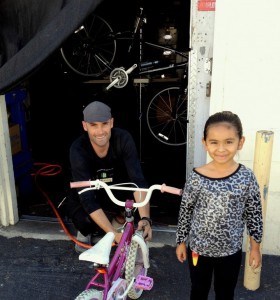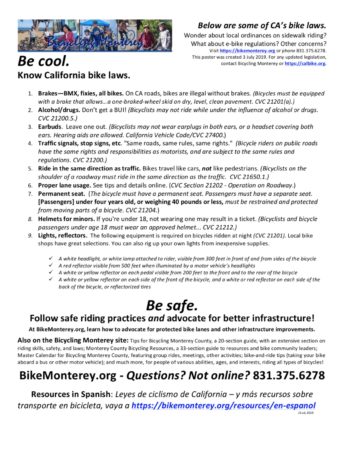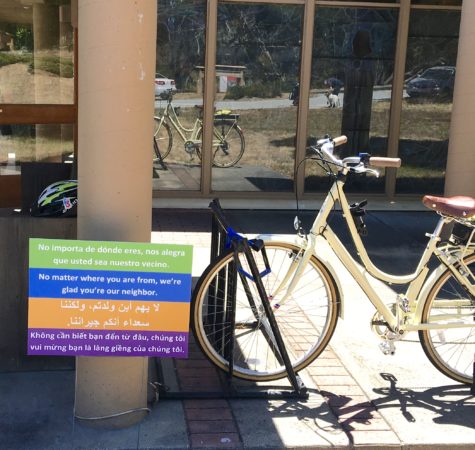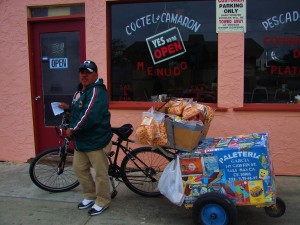Posted by Founder, Bicycling Monterey
ICE Advisory for People Who Bike – Immigrants and Law Enforcement in Monterey County
Información relacionada en este sitio web / Related information on this website: “Haciendo una vida – El conocimiento es poder” / “Making a Life – Knowledge Is Power” https://bikemonterey.org/haciendo-una-vida-el-conocimiento-es-poder-making-a-life-knowledge-is-power.html
Above: A Monterey Peninsula volunteer sharing information on Aug 25, 2019 at the West End Celebration in Sand City.
Report ICE activity: (831) 643-5225 (Monterey County); (831) 239-4289 (Santa Cruz County).
Directory of Immigration Resources / Directorio de Recursos de Inmigración – United Way Monterey County: http://www.unitedwaymcca.org/immigration-information
Spanish is widely spoken here, as reflected in the Spanish-English directories from United Way Monterey County.
However, speakers of some indigenous languages reside in Monterey County too. The top indigenous languages spoken in the county are Triqui, Mixteco, Zapoteco and Chatino–all native to Oaxaca, México.
Court, community, and medical interpreting services in those and some other indigenous languages from Mexico are available from Indigenous Interpreting +, a service of Natividad Medical Foundation, based in Monterey County.
Language services include Chatino, Náhuatl, Purépecha, Tlapaneco, Amuzgo, Yucateco Maya, Mam, Kanjobal, K’iché (Quiché), Mixe, Tseltal, Tsotsil, Mixteco, Triqui, and Zapoteco. Details: http://interpretnmf.com/services/interpreting-services/
Información en español
#KnowYourRights: No importa su estatus migratorio, usted tiene derechos legales.
#KnowYourRights: No importa su estatus migratorio, usted tiene derechos legales. pic.twitter.com/IOgRL3HxDk
— Rep. Jimmy Panetta (@RepJimmyPanetta) July 13, 2019
California is the most diverse state in our democracy and we celebrate that diversity.
— California Governor (@CAgovernor) July 12, 2019
With pending #ICEraids and reported ICE activity happening throughout our state, it’s critical that Californians know their rights.#KnowYourRights pic.twitter.com/DXTx4gXF3r
Make a plan in case worst comes to worst and you’re not there to care for your family. #KnowYourRights ➡️ https://t.co/are1jnkQVt pic.twitter.com/qGP6M7AvRa
— California Governor (@CAgovernor) July 13, 2019
* * *
This post was first published on February 15, 2017, with some subsequent updates.
Update 22 Nov 2018: “Sheriff set to give presentation on ICE activities at the jail” (at Dec 5, 5 p.m. Monterey County Board of Supervisors meeting; public welcome). Report by Mary Duan in Monterey County Weekly, 11/22/18.
Update, 11 Jan 2018: “ICE raids send ‘strong message’ to employers of undocumented workers,” by Cristian Ponce in The Californian, 1/11/18.
Update, 18 Dec 2017: “Sheriff to end practice of hosting ICE agent at Monterey County Jail,” by Sara Rubin in the Monterey County Weekly, 12/18/17.
Update, 24 Nov 2017: “Judge sides with sanctuary cities, including Salinas and Monterey County, against Trump administration,” by Sara Rubin in the Monterey County Weekly, 11/24/17.
Update, 10/28/17: ICE and immigration-related local news will likely be covered regularly by Voices of Monterey Bay, a not-for-profit, multicultural news source launched October 2017 by veteran local journalists Mary Duan, Joe Livernois, and Julie Reynolds Martinez.
Update, 10/9/17: As reported by Chelcey Adami in the Salinas Californian on 10/9/17, “Monterey County officials denounce ICE’s response to ‘sanctuary state’ legislation“: “With SB54, it’s clarified that no county resources may be used to house ICE agents, Monterey County Supervisor Luis Alejo said. Jail officials have said they will adhere to whatever the law advises.”
Update, 6/10/17: As reported by Chelcey Adami in the Californian on 6/9/17, “ICE arrests 19 in Monterey County,” among 54 Central California arrests by U.S. Immigration and Customs Enforcement (ICE) this week, 45 had prior criminal convictions:
- 16 had prior convictions for driving under the influence
- 1 had previously been convicted of another traffic offense
- 5 had records of illegal re-entry/entry into the U.S.
- 23 had prior convictions for a variety of charges (see story for breakdown)
Note also in Adami’s 6/8/17 report, “ICE makes arrests across Monterey County,” that although “ICE contacted Salinas police earlier this week regarding their intent,” and “advised Soledad police that they were going to several locations,” the Monterey County Sheriff’s Office apparently did not receive similar advance communication. Adami reported, “Monterey County Sheriff’s Office Cmdr. John Thornburg said…ICE had not contacted them this time.”
* * *
Update, 2/23/17: In a 2/23/17 press conference with our Monterey Bay Region neighbors, Santa Cruz Police Department, the PD indicated they had been deceived by ICE. Learn more in SCPD’s 2/23 blog post, in the Santa Cruz Sentinel’s 2/23 report (“Santa Cruz Police Chief blasts Homeland Security“) and editorial (“Santa Cruz raids show dangers of DHS immigration orders“), and from Congressman Jimmy Panetta.
Bicycling Monterey cautions: it’s possible that ICE could likewise deceive the Monterey County Sheriff’s Office or other local law enforcement professionals. While Bicycling Monterey’s founder trusts the word of our local law enforcement contacts, it is not possible to likewise trust the administration that issued the 1/27/17 executive order—the administration ultimately responsible for ICE. For more on this topic, see “Immigration – What’s up with U.S. policies?“
* * *
In 2015, I set up a phone conference with Undersheriff Michael Moore (then Chief Deputy) of the Monterey County Sheriff’s Office (MCSO). Why? To ask about the relationship between MCSO and the U.S. Immigration and Customs Enforcement (ICE), and the possibility of the impact of that relationship on people who bike.
Immigrants—both documented and undocumented—are among people in Monterey County who use bicycles for transportation, family fun, or other purposes, thanks to the many benefits of bicycling.
Why does Bicycling Monterey care? Read on. And…
Below the photos, get an update about
ICE, the Monterey County Sheriff’s Office, and people who bike.
Since its beginning, Bicycling Monterey is enthused about the diversity of people who bike. Regardless of economic status, fitness level, shape, size, age, sex, race, native language, immigration status, or why or what they ride, in Bicycling Monterey’s eyes, anyone who rides a bicycle is part of the “bike community.”
Since 2009, Bicycling Monterey’s projects include direct outreach by bike. Immigrants are among the people I meet when I’m out on my bike, such as hospitality workers who bike to work, day and night, or field workers boarding buses headed for local farms. Many appreciate receiving local bike maps in Spanish and English, or Bicycling Monterey materials (when available, contributions allowing), such as Leyes de ciclismo de CA – Laws for bicyclists in CA (Spanish, English) – Summary. (Why paper? As Pew Research data continued to show in 2016, not everyone is online.)
Bicycling Monterey’s activities include: created a Spanish-language resources compilation; researched and compiled other resources for Spanish speakers, including a list of local bike shops with bilingual staff; served as a guest about montar bicicleta con seguridad and more on Radio Bilingüe National Latino Public Radio Network; brought positive attention to the cultural diversity of neighborhoods typically most associated not with their cultural richness but with poverty, such as the Alisal/East Salinas; distribute materials, e.g., Leyes de ciclismo de CA – Laws for bicyclists in CA (Spanish, English) – Summary, which features equipment requirements not found on the state’s website in Spanish; advocate with local organizations interested in creating bicycling resources in the indigenous languages most commonly spoken here (Triqui, Mixteco, Zapoteco, and Chatino—all native to Oaxaca, México); and much more. Photo above: Seaside Police Activities League (PAL) Bike Fair, May 2011.
Photo above: Seaside Police Activities League (PAL) Bike Fair, May 2011.
Photos in this post are not intended to imply
the immigration or citizenship status of the people pictured. Photos are for illustration purposes only.
Photos in this post were shot 2009-2016 by Mari Lynch in Castroville, Greenfield, Monterey, Pacific Grove, Salinas, and Seaside.

 Immigrants in Monterey County and around the nation—both documented and undocumented—are a hot topic as 2017 begins. Bicycling Monterey joined the conversation with a post: “Aussies, others ask: Immigration – What’s up with U.S. policies?“
Immigrants in Monterey County and around the nation—both documented and undocumented—are a hot topic as 2017 begins. Bicycling Monterey joined the conversation with a post: “Aussies, others ask: Immigration – What’s up with U.S. policies?“
That post includes references to some local responses to the January 27, 2017 immigration-related executive order from Washington, D.C. It includes examples from law enforcement (Monterey County Sheriff’s Office and Salinas Police Department), local schools, the Monterey County Board of Supervisors, our congressional representative (CA-District 20 Rep Jimmy Panetta), and others.
On February 14, 2017, Bicycling Monterey contacted Undersheriff Michael Moore, as a follow-up to our 2015 conversation. He was asked:
Has anything changed since 2015 with regard to Monterey County Sheriff’s Office and undocumented immigrants who bike?
No.
[2/23/17 update: But note update at the top of this post, regarding local law enforcement professionals in the Monterey Bay Region having been deceived by ICE.]
Undersheriff Moore confirmed for Bicycling Monterey on 2/14/17:
-
Only people arrested and brought to the jail will have any contact with ICE. Sure, it is possible that someone stopped for a bike law—if they were found to have an active warrant and prior conviction— could find themselves facing an immigration proceeding. However, a simple bike law violation is not considered a serious or significant crime and would not lead to an arrest and booking at the jail.
-
If a Monterey County Sheriff’s Office deputy stopped someone for a bike law violation, the immigration status of the individual would not be relevant, and MCSO’s deputies know they are not to ask that question.
NOTE: Bicycling Monterey does caution people who bike not to take a chance on biking under the influence of alcohol or drugs. Yes, just as driving under the influence (DUI) is a serious offense, it makes sense that someone biking under the influence (BUI) could possibly find themselves arrested and brought to jail. (As mentioned elsewhere on this site, e.g., click here, a BUI is illegal, just as is a DUI, by California law. – It is unlawful to ride a bicycle under the influence of alcohol or drugs. / En California, es ilegal montar bicicleta mientras esté bajo la influencia de narcóticos o alcohol.
As Bicycling Monterey referred to in the 10/20/15 tweet below, many people aren’t yet savvy about bike laws—from knowledge about BUIs to bike equipment requirements and more. In most cases, people don’t break bike laws because they don’t care; they break bike laws because they don’t know what they are.
That’s why, in addition to Bicycling Monterey’s popular section “Riding Skills, Safety, and CA Bicycle Laws,” much effort also goes to help correct common misconceptions about, e.g., sidewalk riding (since regulations about that vary around California and also within individual counties). Unfortunately when Frank Henderson and Mari Lynch wrote an article to counter the inaccurate information shared by the regular staff for the Salinas Californian, a Gannett-owned paper, because Gannett doesn’t translate what they consider “opinion” pieces from the Californian for their Spanish paper, El Sol, those readers only had access to the Californian’s misinformation!
Bicycling Monterey also commonly investigates the details when made aware of a local bike-related law enforcement citation. Regularly, I spend time to be sure that people in Monterey County are not being incorrectly cited (and to date, despite rumors of incorrect citations, no incorrect citation of a person biking has ever been verified by me). As mentioned in Bicycling Monterey’s Constables of the Peace post, we appreciate the bike law knowledge demonstrated by local law enforcement—and that they prefer to educate rather than citate whenever appropriate.
See the Greenfield citation mentioned in Bicycling Monterey’s post about local bike-related ordinances. That’s an example of why more educational outreach is needed to help people who bike know just what California laws and local ordinances are. Want to help?
Contact Mari to volunteer. Or, make a contribution to support this work. The Bicycling Monterey website and all Bicycling Monterey projects are provided by Mari on an entirely unpaid basis since established in 2009.
Bicycling Monterey fliers can be shared, for example:
Leyes de ciclismo de CA – Laws for bicyclists in CA (Spanish, English) – Summary
Be Cool, Be Safe – Bike Law Summary & Advocating for Biking
This post was first published on February 15, 2017, with some subsequent updates.
It was reposted on 22 November 2018 with just one update: a notice of the 5 December 2018 Monterey County Board of Supervisors meeting including a presentation by the Monterey County Sheriff.
On July 13, 2019, in response to the announcement of planned new ICE raids, updates were added at the top of the post—info on Indigenous Interpreting + resources, and resources from the Office of the Governor of California.
This post was published on 22 November 2018. One or more changes last made to this post on 4 February 2020.
























